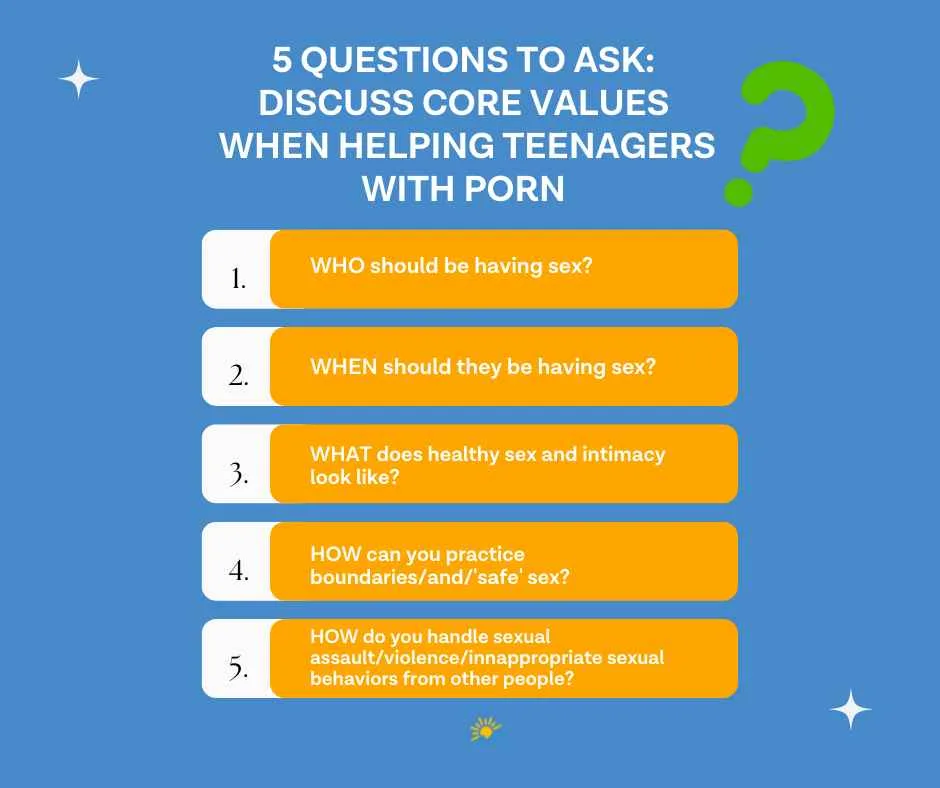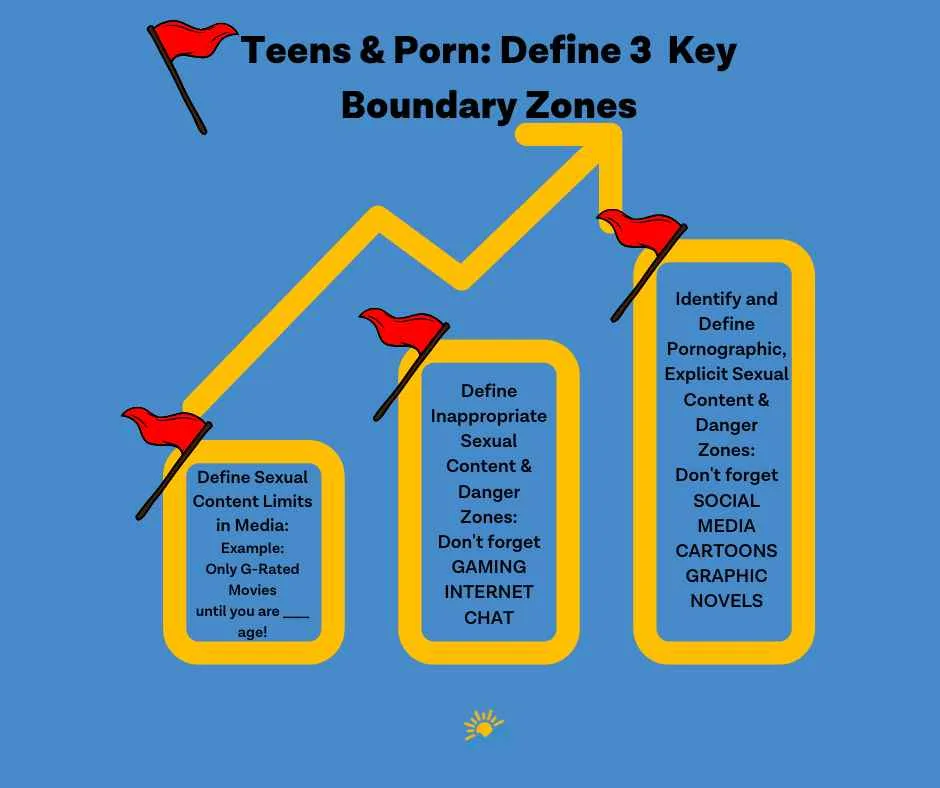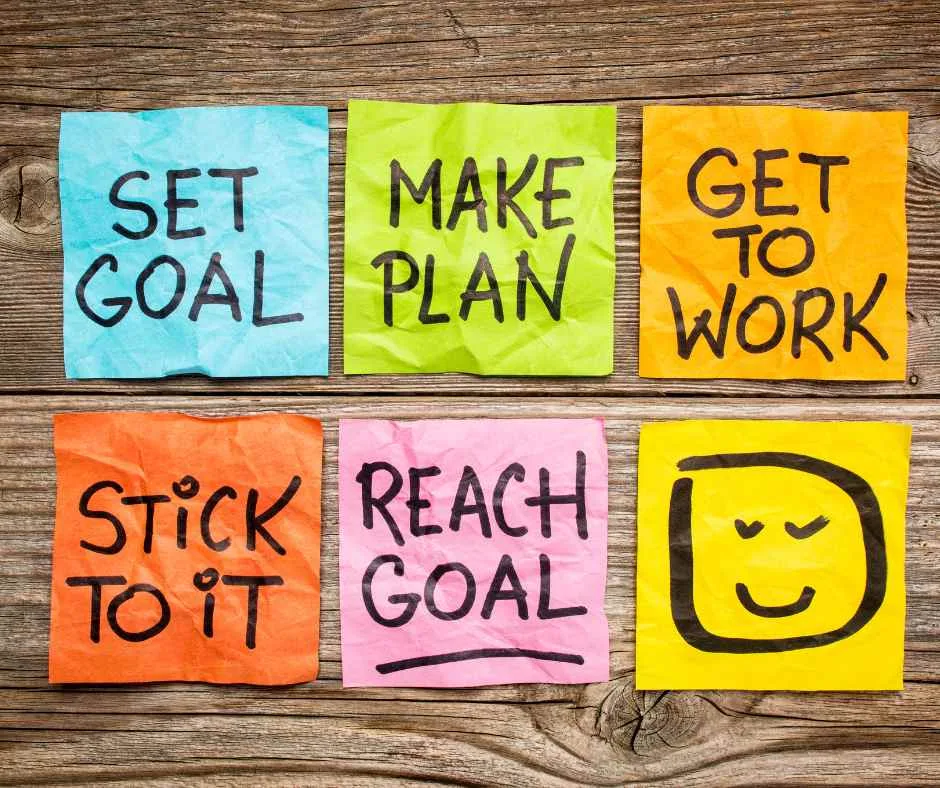Talking to your teens about pornography is one of the most critical jobs for any modern parent. Most teenagers start watching porn between the ages of 10 and 12 years old. Porn use among adolescents leads to all kinds of problems, including lower relationship and sexual satisfaction when they reach adulthood, and higher preoccupation with sex.
It also leads to normalizing sexual violence against women and girls, and thinking nonconsensual sex is ok. Plus, girls at alarmingly young ages feel pressure to post naked pictures of themselves online. As a result, porn is leading to ever-increasing problems with body image among teens.
Parents are the first and most important line of defense when it comes to preventing teens from getting involved with pornography. They also play a critical role helping them understand what to think about porn and how to respond to it when they do encounter it.
In order to help your teens develop healthy values around porn, here are 10 ways to address porn with your teens.
Table of Contents
- Create an Intimacy Values Map – The Foundation
- Have Healthy Intimacy Conversations
- Create Your Family Media Boundaries
- Start Conversations Early – The Logistics
- Limit Access To Devices
- Plan for Accountability and Transparency
- Schedule Check-Ins
- Beware of Social Media Pitfalls
- Create an Independence Plan – The Vision
- Keep Learning Because Technology Keeps Changing
- Works Cited
1. Create an Intimacy Values Map – The Foundation
The first step to approaching your teens and talking about porn is to figure out your own values when it comes to intimacy, sex, and porn. We call this the “Intimacy Values Map.” Create this first, because you can’t clearly communicate your values to your teens unless you understand what you’re trying to communicate! Here are some ideas for you.
Write down your 5 core values related to human intimacy.
Here are the five main areas to consider when opening conversations with your teens.
- WHO should be having sex?
- WHEN should they be having sex?
- WHAT does healthy sex and intimacy look like?
- HOW can you practice boundaries/and/’safe’ sex?
- HOW do you handle sexual assault/violence/innappropriate sexual behaviors from other people?
These values are unique to each individual and each family based on your cultural and religious values. Here are some questions to ask yourself about your values around intimacy, sex, and porn:
- What does intimacy mean to you?
- Is it just sex, or is it more than that? Porn shows a highly sexualized un-reality that is much different than day-to-day, healthy relationship intimacy. What is missing that is so important? For example, what about emotional intimacy, friendship, romance, safety, and trust?
- People have different ways of defining both virginity and even what it means to “have sex.” How do you define this?
- When do you think someone is ready to have sex for the first time?
- When are they not ready to have sex yet?
- Should it only happen after marriage or in a committed, loving relationship?
- If you think people should wait until they’re really in love, how would you know they were really in love?
- In what ways do you think porn is similar or different to how intimacy and bodies are or “should” be?
- What are some reasons you should not have sex?
- What is a good way to ask someone out on a date?
- What should it feel like to have sex?
- Why do people like to have sex?
- How do you avoid pressuring someone to do sexual things?
- How do you say ‘no’ if you don’t want to do something sexual?
- What about homosexuality/people being gay?
- How do you use condoms or contraceptive products properly?
- What should you do if someone does not want to use a condom?
- What about masturbation?
- What are STDs?
- How do you have ‘safe sex’?
Once you have written down your 5 core relationship values, make sure you also write down why. This will help you when you’re communicating these values to your children
Finally, write down 3 goals you have for your teen tied to these values.
For example, “I want to make sure my kids don’t have sex until marriage” or “I want my kids to avoid porn completely” are some goals some parents might make.
Others might choose goals such as, “I want my child to be educated about the dangers of porn so they can make these decisions on their own,” or “I want my child to feel like they can talk to me about anything related to sex or porn.”
Going forward, whenever porn comes up, all of your discussions about it should come back to these core intimacy values and goals. From a big review of multiple studies, it is clear that whatever values you hold and share with your child surrounding sex and porn have a direct influence on their values, attitudes, and behavior. So make sure you’re thoughtful with them.

2. Have Healthy Intimacy Conversations
The first “porn talk” you should have with your teens is not a talk about porn at all. Instead, it’s a talk about human intimacy and the importance of healthy intimacy to having a successful and happy adult life.
Most parents have a first awkward “birds and bees” talk with their kids…and then nothing else. But talking about what to expect from sex with your teens and preteens can help them feel closer to you and feel like they can talk to you about everything.. Parent communication about intimacy and sex also helps adolescents make better, safer decisions around sex.
Also talk to your teen about the intimacy that is missing from porn so that your teen develops realistic and healthy expectations when going into their first intimate relationship. A healthy sexual relationship includes the feeling of being close to someone on multiple levels—in other words, intimacy.
It’s important because feeling intimate with someone leads directly to a more satisfying relationship and sex life. Real intimacy requires good communication and a strong emotional connection – something your teen will not see in porn. And intimacy during sex means that you can avoid miscommunications and unsafe situations.
While people have different views on what it means to be ready to have sex, the important thing your teen should understand is how vastly different porn is from most sex in healthy, loving relationships.

3. Create Your Family Media Boundaries
The final foundational step involves creating your family boundaries or levels when it comes to porn and sexual media. Levels refers to the fact that pornographic content exists on a continuum, and there is not a clear line between “porn” and “not porn.”
These boundaries will differ across families, depending on your religious or cultural values. A helpful guide when trying to set your boundaries is to look at how the rating system for media defines different types of sexual content. There are different rating systems for movies, TV shows, video games, and music (i.e., “parental advisory” labels). These are all meant to help you decide what is appropriate for your child based on their age. Dr. Douglas.org also lists what may be included in each of the media rating systems.
When you talk to your teens about pornography, you need to help explain to them what these boundaries are and why you chose them. Talking to your teen, explaining the why, and then listening to their thoughts, helps them learn to think for themselves. This models boundary setting skills when they come across something inappropriate. Open and ongoing talks also makes sexual media have less of an influence on their sexual choices.
There are three key boundaries to create when helping teenagers with porn:
1. Sexual content (content that is sexual but acceptable to the parents)
Sexual content is anything that shows sexual behavior in the media, and some of it may be okay to you as parents. Some sexual content is less obvious, like flirting, sexual references in PG movies, slight nudity, or some sexual language or storylines about sexual conquests in popular TV shows. Once you know what acceptable sexual content means for you, decide how you will set rules with your child. For example, “nothing above PG until you are [this] old” is an example of a rule about sexual content.
2. Inappropriate sexual content (content that is sexual and deemed unacceptable by parents (i.e. R – rated movies, etc.).
Follow the ratings and set rules around what you consider an inappropriate level of sexual content for TV, movies, and video games. And don’t forget about the internet! As there are not necessarily website ratings, you will need to have conversations with your teen about what it means to be in inappropriate territory.
For example, do you consider Victoria’s Secret, the Sports Illustrated Swimsuit website, and other similar sites to be inappropriate? Be clear about what these lines are. Another rule to set might be keeping the “safe” Google search setting on at all times for all devices. Filtering software (such as Ever Accountable’s filtering on family devices) can help filter out a lot of inappropriate sexual content. Accountability software on all devices can monitor your teens’ activity as well.
Pornographic content (typical sexually explicit material that parents should help kids avoid)
There is the obvious and explicit pornographic content on porn sites that filtering and accountability software will do a great job of either blocking or reporting. But consider pornographic accounts on social media, video games that border pretty clearly on porn, cartoon and graphic novel porn, and R-rated or TV-MA movies that have pornographic (rather than just inappropriate) sex scenes.
Make sure that these boundaries are clear to both you and your child. You might not know all of these ahead of time, so keep the conversation open and adjust the levels of boundaries as you go. Also, because teens need to learn to think for themselves around these issues, try involving them in this process whenever there is new content. If they view something in a gray area, ask them what they think about it and decide together which level it belongs in.

4. Start Conversations Early - The Logistics
Now it’s time to talk about what you’ll do now that you have the foundational steps completed for helping teenagers with porn.
The first important thing to understand is that you need to start earlier than you think. Most parents start talking to their kids about sex around the middle of puberty, usually around 12 and 15 years old for most teens.
It’s vital to consider that many teens have started to view pornography regularly by 12. Many have been exposed to porn by 10. Children and teens are naturally curious about sex and bodies. However, many parents are hesitant to talk to their children about porn because they think they are “too young.”
Unfortunately, porn then ends up being the main source of sexual education for many youth. Because of this, you want to have these conversations before they encounter porn. We recommend starting these conversations between the ages of 8-10.
How to start the conversations early
Smaller children won’t really understand what they see in porn. When first starting the conversation, keep it to the basics. Be clear, direct, and use real names for body parts and sex.
Focus on things like: how important it is to keep our bodies private, how sex is only for adults, teach them about consent, inappropriate touching and how to recognize “good touch” versus “bad touch.” If you have not had open conversations about how and why bodies change, how babies are made, how sex works, etc., make sure to explain these basics too!

5. Limit Access To Devices
Limiting access can include rule-setting (such as rules around the “levels” above), not allowing screens in your child’s room (especially when they go to bed), limiting screen time (per day or per week), parental control settings on all their devices, and filters. Our filtering software is included with our family plan, and easy to turn on at will—and there are no device limits, so you can turn it on for all of your family’s devices.
This approach is great for limiting your child’s access to porn in the home. However, don’t forget, they can still access it from outside sources, and filtering doesn’t catch it all. Therefore, it is crucial that you keep an ongoing conversation going about what your child has been viewing, and discuss it in the context of your values. This is the best way to help your child start to internalize those values and limit their access on their own.
6. Plan for Accountability and Transparency
Parents tend to underestimate how much porn their children are viewing. But the research shows that your involvement and awareness of what your teens are up to has a direct effect on how much porn they view. Your involvement also impacts their sexual behavior.
That’s why having conversations, setting boundaries, and letting them know that you will be checking on their online activity is so important.
Before installing accountability software, don’t forget to explain to your teens the purpose of accountability software in context of your intimacy values. Then, look at the reports often.
When you see something that seems pornographic, approach them without shame or judgment. Simply ask them what they saw and how they felt about what they saw. Then ask if they have any questions. Have the conversation about real-life intimacy again…and again…and again.
Also, accountability doesn’t just involve what your teens do in your home. A key step to helping teens with porn is monitoring who they are with and asking about what online activities they engage in with friends or at school. Remember, online pornography can be accessed almost anywhere.

7. Schedule Check-Ins
Your most powerful moments as a parent will always be the one-on-one time you spend with your children. Discussing pornography is no different. Nothing else you do will compare with one on one discussions you have with your kids about porn. As they go through their teenage years, it is critical that you schedule regular check-ins with them. Ask open-ended and specific questions like:
- a) How are you doing? (with your full, loving attention)
- b) Are you viewing porn? (ask them directly)
- c) Do you have any questions for me?
We recommend checking in with your teen around four times per year to talk about these issues. Think about your tone going in, as that can influence how comfortable your teen is with these conversations (try not to be too doomsday!). It is normal to feel awkward in these conversations, but push yourself to be clear and direct.
Most importantly, never shame or belittle your child for looking at porn. Instead, ask them how they feel and think about what they have seen. Discuss plainly how porn is different from real life or inappropriate. Remember, you don’t want to make them feel shame for the natural attraction to the human body that porn capitalizes on.
Base all of your information on your intimacy values and what you believe about sex and relationships. Finally, explain any rules you will be setting to limit their access and why.
Also, don’t forget about boys! Parents tend to have a lot more conversations about these topics with girls than boys, mostly because moms tend to talk to girls, and dads tend to talk to boys. Men are often less comfortable, generally, talking about sex and intimacy. But boys need just as much education, particularly because they are the highest users. Porn has a direct effect on their sexual behavior.
8. Beware of Social Media Pitfalls
Although filtering out and trying to limit access to pornography websites is critical, many teens actually get access to pornography and other inappropriate sexual content through social media. Each social media platform has different rules and regulations regarding nudity and pornography, but pornography can be accessed on any platform. For this reason, it is very important that parents of teens keep a tight watch on the social media use of their teens.
Some key social media tips include:
- keeping an eye on who your teen follows on their social media platforms
- limiting phone and screen time
- not allowing them to have smart phones or other screens in their rooms, especially at night
Filtering can block some social media accounts that contain explicit pornographic images. For young teens, there are ways depending on the platform where you can have your child’s account run through you first so you can see direct messages and follow requests. Most importantly, keep this as part of your ongoing conversation with your teen about what is and is not appropriate (and why).

9. Create an Independence Plan – The Vision
Eventually, your children will be adults and out of your home. The end goal of all your conversations about porn with your teens is not about restricting or monitoring their smart device access forever. They need the ability to monitor themselves when it comes to porn.
To succeed, you need to start helping them develop the ability to think critically about the content they come across, and internalize strong values around media use. This will lead to smarter decisions in the future. With that in mind, you need to have a clear independence plan in place as your teens get older.
Some examples of concrete steps you can take are:
- Gradually increasing the amount of screen access they have in their rooms.
- Gradually relaxing your monitoring and/or filtering.
- Gradually reducing or limiting accountability software (depending on how problematic your teen’s porn use is).
- Helping your teen set up commitments and goals related to porn use.
Clear and firm commitments lead to a positive sense of wellbeing and healthy functioning—as long as they’re achievable and likely to be kept. One way to make sure these goal-commitments will stick is to help teens develop something called an “authentic inner compass.”
This happens through conversations with your teen to help them identify for themselves what they truly value, need, and want out of life.
Ask them to think about what they want out of intimacy. This will help them make moral decisions on their own in this important area.

Whatever you do, keep the following in mind as you slowly start to increase a teen’s independence:
- Keep the conversation open. In a study of 313 teens, those whose parents kept an open conversation about porn were far more likely to accept their parents’ involvement in their internet activities.
Open communication is when both people can share how they think, feel, and view issues surrounding porn.
When parents have open communication with their children, it increases their childrens’ personal development and leads to higher well-being, self-esteem and positive coping skills.
Also, the more you talk to their teens about it, the more likely they are to resist porn on their own.
- Take your teen’s perspective. Get into your child’s shoes and remember what it was like to be that age!
You need to feel like your opinion matters, and being tightly controlled can feel suffocating (and lead to rebellion a lot of the time!).
Remember that they are naturally curious about sex and bodies and their hormones are off the charts.
Also, they probably get a lot of messages from their peers and other media telling them that porn is “harmless,” and their peers are very important to them.
Whenever you disagree about something, try to understand where they’re coming from and why they think the way they do.
Even if you have to “lay down the law,” make sure it’s done in a way that validates where they’re coming from.
- Avoid controlling language. Phrasing things with words like “must” and “should” will shut many teens down from having open conversations with you, and will not help them develop the ability to make healthy decisions on their own.
Instead, give them information and invite conversation about each point you make.
Also, when monitoring and using filtering software, be open with your teens about why you are doing so, rather than approaching it in terms of trying to control them.
- Offer meaningful choices whenever possible. For example, rather than just telling them that 9 pm is the cutoff for screen time, explain to them why you are coming up with a screen time limit at night. Then ask them for their opinion on a good time frame to turn in their device.
Try working together in any areas possible so they start to feel a sense of ownership over their behavior.
10. Keep Learning Because Technology Keeps Changing
Finally, you as parents need to keep learning and growing your sense of personal resources and knowledge about the dangers of porn and intimacy-related issues.
There are countless books and online videos that are meant to help teach you and your children about these topics. Your child’s sex education curriculum could help, as could the advice from other parents. There are also many Ever Accountable resources that will continue to grow, including “How to talk to your kids about porn,” and more.
And read our other resources on the dangers of porn so you feel more empowered going into these discussions with your child. Educated parents are more comfortable talking to their children about porn and intimacy, and their kids get more benefit from the conversations.
If at any time you feel lost and out of your depth, ask a professional for help—such as a pediatrician or mental health professional.
You have real power to make a difference in your child’s porn use and even how they think about intimacy and porn longterm. Set and enforce rules, monitor, and most importantly, talk to your child (starting early!) about both what intimacy means and how much porn differs from reality.
Works Cited
https://link.springer.com/content/pdf/10.1007/s12119-012-9132-7.pdf.
https://link.springer.com/article/10.1007/s40894-016-0049-5.
https://www.ncbi.nlm.nih.gov/pmc/articles/PMC4857605/).
The TV Parental Guidelines, http://www.tvguidelines.org/. Accessed 28 October 2022.
https://onlinelibrary.wiley.com/doi/pdf/10.1363/4205610?casa_token=0asQXwMvzZwAAAAA:s_iGcTjWdC0Bdn6iT7a8DxWLp52RfUtKq4QvQ3OWPi9RNzJFv40Qow1501aI8bcyFrRiHSqoEc-oYh0GZQ.
https://journals.sagepub.com/doi/pdf/10.1177/0093650220952227?casa_token=pCv9IDGK2owAAAAA:e_rvZjofZKNhiXVYqfRpV23VJQnPVMsFUYFoMzsyn84C3cN4_IaZIYfoeq0ciyQKtJwUpNuCKGj0.
https://www.tandfonline.com/doi/full/10.1080/00224499.2016.1143441?src=recsys.
https://link.springer.com/article/10.1007/s11031-019-09809-2.
https://www.tandfonline.com/doi/pdf/10.1080/15213269.2015.1054944?casa_token=KlYUYpOxBmYAAAAA:KxOxdeNs5APjrshrFW6-4hGs7I-xMGnmmuqKjUB8PGQQzvM_2QkxKHSYQ8M7q_LwJWuKVv3wSyLJ.
https://journals.sagepub.com/doi/pdf/10.1177/0093650220952227?casa_token=pCv9IDGK2owAAAAA:e_rvZjofZKNhiXVYqfRpV23VJQnPVMsFUYFoMzsyn84C3cN4_IaZIYfoeq0ciyQKtJwUpNuCKGj0.
Elliott, Marc N. “Timing of Parent and Child Communication about Sexuality Relative to Children’s Sexual Behaviors.” NCBI, 9 August 2017, https://www.ncbi.nlm.nih.gov/pmc/articles/PMC5549786/. Accessed 28 October 2022.
“ESRB Ratings Guides, Categories, Content Descriptors.” ESRB ratings, https://www.esrb.org/ratings-guide/. Accessed 28 October 2022.
“Film Ratings.” Motion Picture Association, https://www.motionpictures.org/film-ratings/. Accessed 28 October 2022.
“Home.” YouTube, https://scholarsarchive.byu.edu/cgi/viewcontent.cgi?article=5001&=&context=facpub&=&sei-redir=1&referer=https%253A%252F%252Fscholar.google.com%252Fscholar%253Fhl%253Den%2526as_sdt%253D5%25252C48%2526sciodt%253D0%25252C48%2526cites%253D9608839597343647660%2. Accessed 28 October 2022.
“Home.” YouTube, https://srcd.onlinelibrary.wiley.com/doi/pdfdirect/10.1111/cdev.13515. Accessed 28 October 2022.
Morawska, Alina. “It may be awkward, but we need to talk to kids about porn.” The Conversation, 25 November 2015, https://theconversation.com/it-may-be-awkward-but-we-need-to-talk-to-kids-about-porn-43066. Accessed 28 October 2022.
“The Rating Systems for Media Products.” Douglas A. Gentile, https://drdouglas.org/wp-content/uploads/2019/03/the-rating-systems-for-media-products-1.pdf. Accessed 28 October 2022.
14-Day Free Trial
Protection From Pornography
Change your habits, change your life: Start our 14-day free trial to help get rid of pornography for good.



